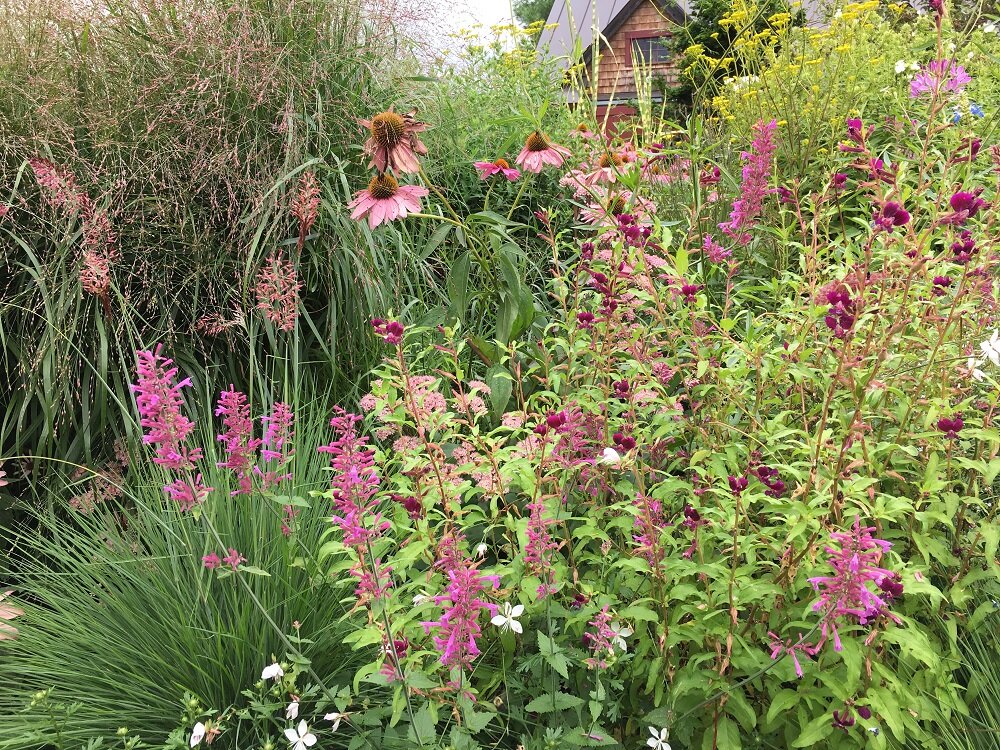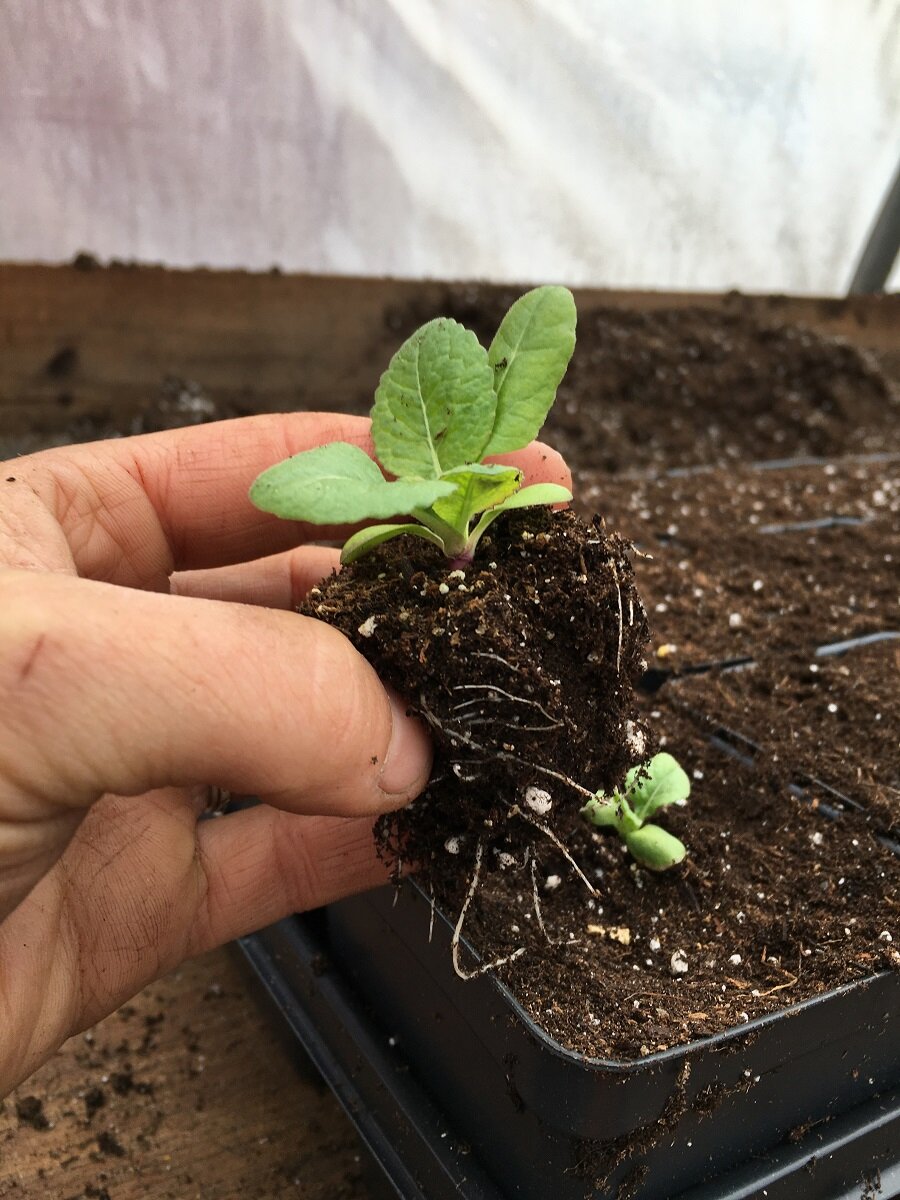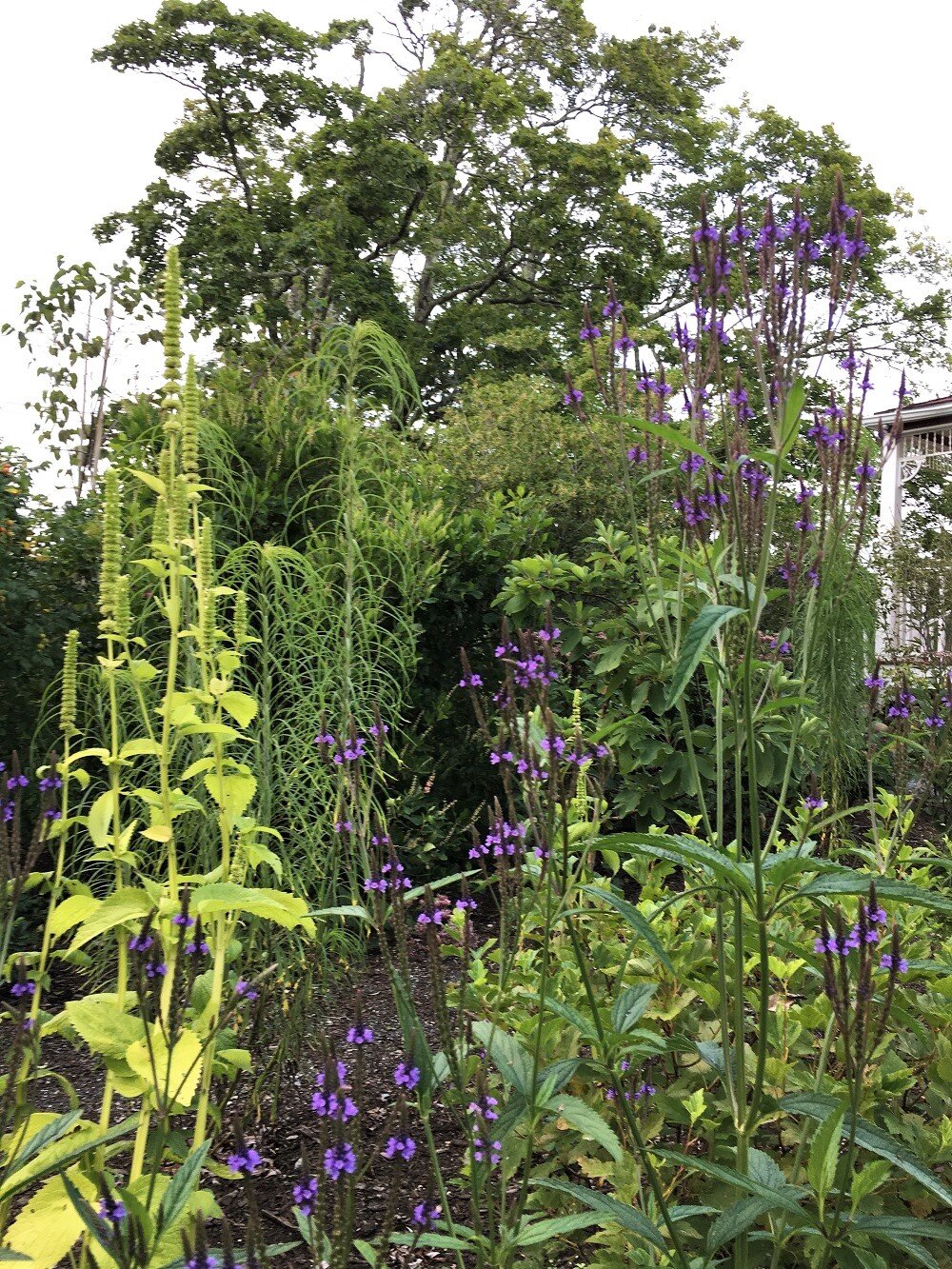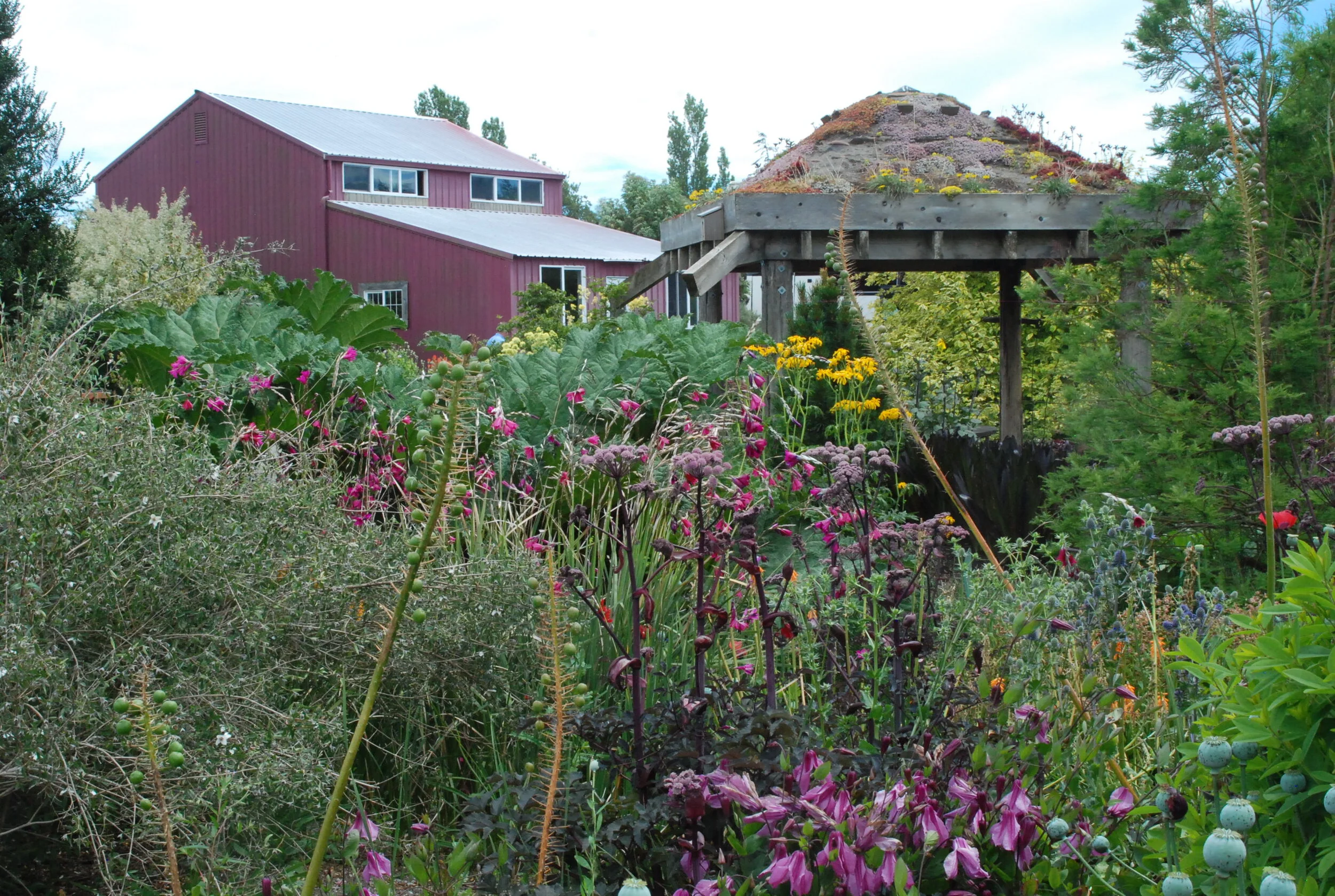Specialty Nursery Profile: The Bunker Farm, Dummerston, Vermont
Pretty in pink: Panicum virgatum and tender Melinus nerviglumis with Echinacea purpurea, Agastache, and Cuphea lanceolata ‘Purple Passion’ - the annuals (Melinus, Agastache, and Cuphea) are all available from the Bunker Farm.
Plinth et al has previously featured the Bunker Farm co-proprietor Helen O’Connell before in 2018 (please see the original interview (https://www.plinthetal.com/blog-1/2018/01/09/5-10-5-horticulturist-garden-designer-nursery-owner-helen-odonnell-of-bunker-farm). In the last few years, Helen has increased her presence at plant sales, which has enabled her customers to purchase choice annuals, biennials, and some perennials. I have been a repeat customer who can vouch for vigor of her annuals - all have thrived in my inner city garden. Because the plant sales have been cancelled this year, she has now transitioned her business to pick up and local delivery sales. However New England gardeners should count themselves to have Bunker Farm as a source of uncommon annuals and biennials since these plants are not typically sold in garden centers and big box stores. Most are good pollinator food sources as well as being compatible with perennials and woody plants in mixed plantings (tall growing annuals seem to be accursed in the commercial trade).
Operating a nursery that largely sells annuals is like operating a restaurant whose menu is seasonally-driven and profits slim. Unlike perennials which you can save and bulk up for future sales, annuals have short shelf lives. With the cost of materials (pots, potting medium, greenhouse oil for heating) going up, how do you balance between financial loss and breaking even?
The best way to think about Bunker Farm Plants is like an appendage to two other businesses- the Bunker Farm as well as my gardening business. My main occupation is my garden design, installation and maintenance business which in New England is about a 7-8 month seasonal business. One way to extend this season is by growing plants. After my time volunteering in the garden at Great Dixter I learned that you could garden with as many interesting and unusual plants as you could possibly want, all you had to do was grow them yourself! All of a sudden, gardening and design wasn’t limited to the plants I could buy- just limited by what I could grow and how well I could grow them. That is so exciting! That is really what my nursery business is all about. The other piece of the pie is how the nursery nestles into the Bunker Farm, a business I started with my husband, my sister and her husband, where we raise animals for meat, produce maple syrup and operate a plant nursery. When we purchased the farm it came with a vacant greenhouse, which was a perfect fit for me to try out plant growing during the long winter months. The advantage to growing so many annuals (and about ¼ are perennials, but usually they are sold as first year seedlings) is that the nursery itself is seasonal. I can really shut it down by July with nothing to water and no stock to keep over the winter. In terms of the plant nursery’s profitability, it is best to think about it as a slice of the pie- it contributes to the overall picture. A good way to think about it is like this: If the Bunker Farm was made up of three roommates, Meat, Maple, and Flowers, if flowers went away, Maple and Meat would each have to pay more rent. The nursery is just one piece of a diversified farm business.
We previously established that predicting what plants will be popular and sold out is a lottery. Sometimes it is clear that no matter how we educate and inform customers, we are unable to sell the plants. Since the last three years you have been on the road selling plants at gardening events and plant sales, how has your approach towards sales have evolved?
People ask me all the time how I decide what to grow and the best answer is that I grow what I am excited about. Trying to guess what people will like is very difficult and it turns out that if I am not excited about a plant, I can’t sell it very easily. I am passionate about my plants because of what they will eventually do in the garden- and I think that comes through when talking to my customers. The other thing that seems really clear to me that the strength of my business and probably most businesses is in the relationships you form with your customers. The best thing is a repeat customer, seeing those familiar people each year. I recently came up with a tagline for the nursery, Unexpected plants for the Intrepid Gardener; those are the people and those are the plants I am most excited about. I am very honest about what plants are capable of. I don’t want people to buy a plant that ends up disappointing them, so I will say, yeah, that one will be done by the end of June. For some people, that’s it, they don’t want it after that. When that doesn’t deter people, then I know that plant has caught their attention and that’s kind of special. And once you have the plant bug, an adventurous gardener isn't easily deterred by anything if they are curious or attracted to a plant. I personally love those early season annuals, they are the most unexpected things in June, especially in New England. To have the California bluebells (Phacelia campanularia) with trailing absolutely cobalt bluebells on speckled purple veined foliage- no one around here has seen anything like that before. So even if it disappears by the end of the month- that moment was worth it and underscores how many different moments you can have in one growing season.
Given that your approach towards sales has evolved, how has your original business plan been revised to reflect the successes and failures?
The business plan is always evolving and the farm is currently in the process of writing the next five year plan. It seems like each year there are more flower customers and more demand, we have been employing steady growth over the years. We will continue to slowly produce and sell more. I’d like more people to come to the farm but I also recognize that many of my customers are far away. This year, because of all the specialty shows and market closures due to the COVID-19, I am considering delivering my plants to far flung geographic locations. Figuring out how to get plants to a broader market is important for small specialized nurseries. Figuring out how to vary my pricing seems like an important step. Common easy to grow things should be cheaper than the tricky, low germination rate plants. Figuring out what size pot plants will be the most successful in is also tricky. Timing is everything and that is an evolving process.
You have handled cut flower production on a small scale. Given the current health crisis that is causing a fallout in the cut flower industry, how will you justify the side of the business this year?
In the early days I did more cut flowers and arranging, but over the years that has pretty much fallen away as the plant business and my gardening business has really taken off. My heart goes out to everyone in this business (flowers and nurseries) having to try new things, cut back, be creative and diversify. This year will likely not be the best for plant sales with the trade shows all canceled, but with all the other pieces of the farm we should be able to weather the storm.
Growing plants from a seed is a continual experiment that keeps one’s on your toes. One year would be successful for one annual, but another year would be an entire failure. Would you be willing to reveal any recent changes you have adapted to increase your success and quality of the seedlings you produce?
This might sound really simple, but I realized that I just need to water more. I have a very hot and dry greenhouse, there is nothing damp and murky about it. Young seedlings need to be protected from drying out. I had trouble with young tender plants last year and it took me awhile to realize that in those few days after transplanting into a plug tray, the seedling does not want to dry out- even a little- they must be kept constantly damp. I was always worried about over watering, but in my greenhouse that is not really a problem. So far this year, things are kept more moist and transplant rates are higher.
Finally a simple question – what plants would you like your customers to try this year?
One of the plants I loved the most last year was Verbascum roripifolium- I grew it on a whim last year, knowing nothing about it. I couldn’t really promote it during sales season because I had no idea how awesome it was. A great nurseryman Russell Stafford saw that plant on my table and told me it was a great plant. Not until I planted it and saw what it was capable of, did I truly understand. In early summer it put up a spike and started to bloom into a wiry like cloud of little yellow verbascum flowers. They close up during the day, but the little bud beads are appealing and in the early morning when it is open to the light, the plant is just glorious. Over the entire season it bloomed, continuing to branch like a wiry mass of hair, the central stalk needed a stake, but otherwise the flower cloud stayed afloat. It is an awesome plant. Hopefully this year I won’t find a billion seedlings and discover that it is terribly weedy or something. All sites claim it to be perennial and hardy to zone 3- it’s hard to imagine a plant could be that great and also a perennial… Can’t wait to find out.
The plant I was most excited to meet for the first time last year was Agastache nepetoides. I saw it grown by my friend Emily Henry and planted beautifully by her partner Caleb Davis in his wildly gorgeous borders on the coast of Maine. This plant easily stood 5-6’ tall, with greenish gold flower spikes. It was so upright and forthright. They collected seeds from the best plant and sent them to me. I now have some good looking seedlings..
I could go on like this about most of my plants I am sure- really fun annuals this year? Any of the cuphea- they are always so so good, bright, colorful and long lasting. The California poppy Mikado goes through to the fall if planted in a good gravelly spot. And I am just loving the incarvilleas (‘Cheron Pink’ and ‘Cheron White’- really good looking plants for the whole year, with graceful flowers. Osteospermum ‘Sky & Ice’ was also surprisingly good and long lasting. Lastly, any of the Euphorbias I am growing- I have collected seeds from E. donnii, E. characias ssp. wulfenii, E. oblongata and others. They are great textural foliage additions to gardens and containers and still worth growing as annuals in colder climates.
INTERVIEW BY ERIC HSU WITH HELEN O’CONNELL
PHOTOGRAPHY BY HELEN O’CONNELL














